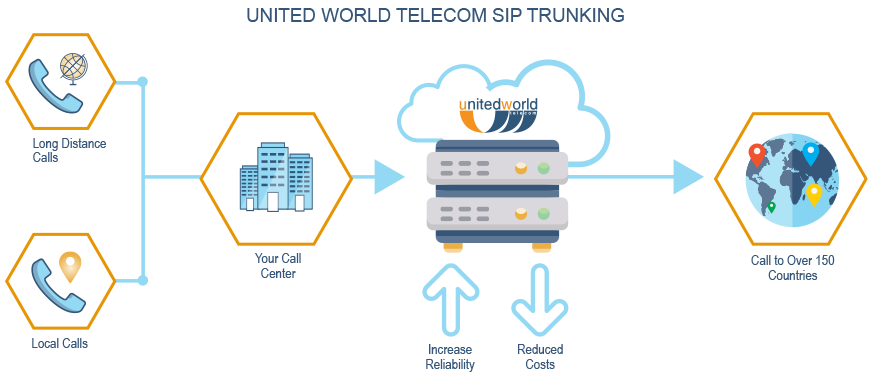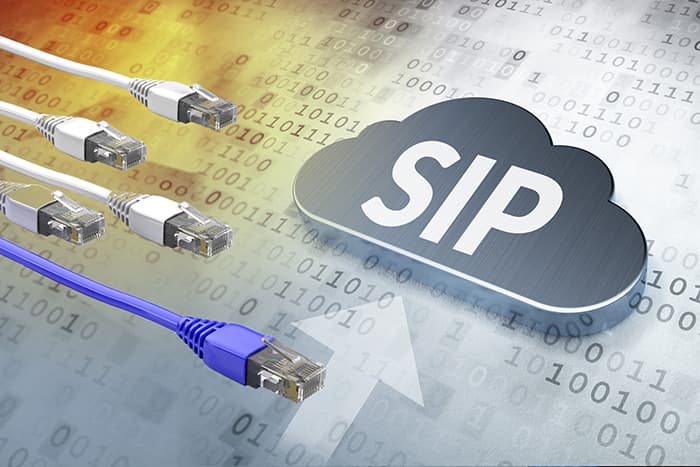Has your business considered upgrading its legacy ISDN phone system to gain new features and capabilities? Then, you must consider an ISDN to SIP migration.
SIP trunking is cost-effective and highly scalable. And this makes it an excellent choice when upgrading your phone system.
Here is a brief guide to replacing ISDN with SIP trunking, including the benefits of an ISDN to SIP migration and the different steps involved to make this transition smooth and cost-effective.
Why Switch to SIP?
SIP phone systems are often considered a modern alternative to traditional business phone systems. By replacing ISDN with SIP systems, you can add more flexibility and scalability to your phone system.
It is a good practice to upgrade legacy phone systems to take advantage of updated and advanced technologies. Here we will look at how you can migrate to SIP and what an ISDN to SIP plan looks like.
How Can SIP Trunking Benefit Your Business?
There are many benefits of switching to SIP trunking, from making your phone system cloud-friendly to aiding in global expansion to bringing more flexibility.
SIP trunking uses session initiation protocol (SIP) to send voice, video, text, and other unified data through the internet instead of traditional POTS lines. With this ability, you can run your business communications from any location and connect with your team wherever they are located.
And the best part? You don’t need additional hardware or new equipment to get your SIP system running. Global SIP trunks can easily integrate within your existing PBX. So, you do not need to install a new system. Simply bring SIP trunking into your current system. Additionally, your business can even expand to new markets and regions without increasing overhead costs.
So, with SIP trunking, you get a more advanced and scalable phone system while keeping your communication-related costs low.
What to Keep in Mind When Migrating to SIP Trunking
When doing an ISDN to SIP migration, note that:
- You will need to conduct an audit of your current phone system to gauge the scope of the migration.
- Since SIP can work alongside ISDN, switching won’t cause any downtime or interruptions.
- Tests that ensure the system runs smoothly can be conducted around your business’ schedule and activity.
- Research different SIP trunking providers to get a sense of what they offer and what their rates are.
Debunking SIP Trunking Myths
When it comes to new (and complex) technology, it is easy to get sucked up in misinformation and doubts. And so, before we discuss how to migrate from ISDN to SIP, let’s go over some common SIP trunking myths and discuss them:
- SIP call quality is poor — When it comes to digital communication, there is a tendency to believe that communicating over the internet can cause packet loss, latency, and network jitter. But SIP trunking uses dedicated IP connections designed and optimized for high call quality. Because of this, they offer the same, if not better, call quality than ISDN calls.
- SIP trunking comes with hidden costs — SIP trunking is a cost-effective alternative with two primary costs: monthly fees and call costs. You choose the plan at the beginning of your contract. With the plan, you can make and receive local and international calls for low costs. And there are no installation or set-up fees involved. In fact, with some providers, you won’t even pay a cancellation fee, if you choose to find another provider. One additional fee might be to upgrade your PBX system and internet bandwidth if you have low internet capacity. But even with these costs, you will find the service ROI-friendly.
- SIP trunks are not secure — Another common misconception is that cloud communications (like other internet services) come with cybersecurity risks and can be easily hacked into. However, with advanced technology, cloud communication, and SIP trunking providers offer a great deal of security. Additionally, you will need to work with your internet service provider to ensure firewalls and security measures are in place.
- Migrating to SIP will result in downtime — As we mentioned before, many are afraid that switching services or communication systems can lead to interruption and downtime. However, with SIP trunking and a quality service provider, you can minimize VoIP downtime and migrate without pausing your service.

ISDN to SIP Migration in 7 Steps
So, what does an ISDN to SIP plan entail and how can you prepare for such a migration? Here is a 5-step plan to replace ISDN with SIP trunking:
1. Identify and Document Your Requirements
Before you get started, you need to identify what you need from this migration:
- Do you need new business phone numbers? If so, how many numbers do you need?
- What types of numbers do you need: local or toll-free?
- Do you need call management features such as cloud IVR, auto-attendant, call queues, call monitoring, and so on?
- What locations do you need calls forwarded to?
- Do you need extensions or dedicated numbers (also known as direct inward dialing numbers) for specific employees or departments?
- Do you need a softphone to support remote workers?
It is also a good practice to document what you currently have and want to keep, such as phone numbers, extensions, voicemail inbox, etc.
Once you determine what you need from your new system, you can start planning for the SIP migration.
2. Communicate with Your Employees
Before making the switch, bring your employees into the migration process. Get their input and feedback to identify additional areas of conflict and improvement. Some questions to ask employees include:
- What do you think of our current business phone system?
- Have you encountered any issues using this phone system? If so, provide details.
- What would you like from a new phone system? Explain why.
- Can you think of anything that will improve internal and external communication?
3. Make a Plan and Scope the Job
The next step to replacing ISDN with SIP is to make a plan. This will help you determine what your business should expect in terms of scope, transition, and cost. Depending on the state of your current system, you may have to transition in parts (floor by floor or branch by branch) or migrate the entire system in one go.
Work with your communications or SIP trunking provider to get an idea of what the transition will look like, and how your business can prepare. When preparing your plan, consider the following:
- Employees — List down all staff members and collect their contact information.
- Vendors and suppliers — List down contact information for essential vendors, suppliers, and service providers.
- List all communication equipment — Create an inventory of all business-related phones, laptops, computers, desk phones, fax machines, smartphones, etc.
- Call routing — Identify what numbers will route calls to which numbers and locations and when.
- Backup data — Make sure information and data are backed up and that backup processes are working properly.
- Setup safekeeping for critical data — Keep critical data extra safe as you may need this to enact disaster recovery and business continuity. Think logins and passwords, alternative numbers and phone and lines, etc.
- Include remote working capabilities — Here’s an opportunity to explore remote working options for your employees. Review how your new system can support this flexibility.
- Create and test a business continuity plan — This plan will help your business continue working and offer services if something goes wrong.
4. Conduct an Audit: Evaluate Existing Systems
Next, evaluate your current system and anticipate possible problems and changes required. Look at the infrastructure and bandwidth capacity. What is your current system lacking that a SIP phone system can solve?
Check with your SIP provider how much bandwidth and network capacity you will need for your business’ call volume. This information will help you decide if additional connections are required to prioritize voice traffic over other internet usages. Similarly, communicate your call volume expectations with your provider. They will help you understand what infrastructure will work best for your business needs.
Lastly, you may even want to let your provider on future expansion plans. This will help you determine if this provider’s service is scalable and can assist your business in growing when it is ready.
5. Get and Install a SIP Trunking Service
Once you’ve completed the audit, the next step is to find a reliable SIP trunking provider and subscribe to the service. Research different providers to get a sense of what they offer and how much they charge.
You should also look for additional features and tools they offer that can further enhance your business communication system; for example, call management features like call routing or softphones, and so on. Another important factor in choosing a SIP trunking provider is their support team. Is their support team easily accessible? Do they offer 24/7 customer support, in case your business needs help off-hours?
Once you’ve settled on a SIP provider, it’s time to set up and get your SIP system up and running. One significant benefit of replacing ISDN with SIP is that SIP trunking requires less equipment and hardware. And since most SIP services are hosted and maintained by your SIP provider, you have little to no installation. You might need to tweak and adjust minor things, and you might choose to install the service section by section. This ensures no downtime or interruption.
Finally, prepare for the ISDN to SIP migration by getting the right equipment ready.
6. Test Your New SIP System
As you set up your SIP phone system, you must test it and its different components to ensure everything is working smoothly. Most SIP systems can integrate with other business applications such as CRMs, video conferencing tools, APIs, and so on. Test your system with core business applications to identify any issues or hiccups. Similarly, your provider should test the service and phone numbers before the system goes live. Keep your business continuity plan ready, in case there are any issues and you need a backup.
7. Go Live and Make Business Calls
Finally, once your SIP system has been tested and any issues have been resolved, you can fully switch over to SIP. The installation and activation of the system is relatively quick; it is the preparation that can take some time. However, with the right SIP provider and the right tools, this transition will occur smoothly, and your business communication system will work effortlessly.
Ready to Switch Over to SIP?
If you are looking for ways to upgrade your existing business phone system without increasing expenses, then SIP trunking is the way to go. Want to learn more? Our experts at United World Telecom can help you understand how SIP trunking works and how it can help your business specifically. Call us today at 1 (877) 898 8646 or chat with us online!

